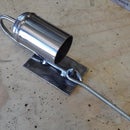Introduction: Simple Time Management - Plan Your Week
Like many people, I have been using a diary to plan my days for many years, but it's only recently that my planning system has evolved into something that I consider to be helpful enough to recommend to others.
This system has proved to be:
- simple to use,
- easy to see the whole week at a glance,
- easy to reproduce,
- way cheaper than buying diary refills.
Step 1: Getting Set Up
You will need...
- A loose leaf planner or folder
- Access to a printer
- A sharp blade and steel ruler
- A hole punch
- A pen
- A couple of highlighters
Print the attached PDF "Weekly Planner". There are two weeks on each sheet so print as many weeks as you need divided by two.
Use a sharp blade and a steel ruler to cut the pages in half to create two weekly planners from each one.
Punch or drill holes to suit your folder. If you only have a few pages to do then a wad punch is the way to go. If you want to lots of pages they can be drilled by following my earlier Instructible.
Put the pages into your folder and you are ready to start planning.
Attachments
Step 2: Start Planning
At the beginning of each week start with a fresh page.
Put the date at the top.
Refer to the previous week's page and list all unfinished tasks in the spaces below "Tasks". Also check for any notes written on the black left-hand sheet.
Add any new tasks that need to to be attended to this week.
Do not worry about listing the tasks chronologically. It isn't necessary.
When all your tasks for the week are listed start thinking about any that need to be completed before others can be started. Think about the structure of your week. When you think you know the best day for a particular task use your favourite highlighter and colour the space to the right of the task that corresponds to the appropriate day or days of the week.
If you know the approximate time of the day the task is to be started this can be indicated with a small dot inside the coloured day space. Imagine the space is a clock face and put the dot where the appropriate hour would be. This isn't meant to be super accurate - it's just a guide.
Tips
- If you find you have more tasks that fit on a page, try grouping some together under one task.
- If you need to refine your daily plan then a similar system can be used each day listing hours rather than days.
Step 3: Work Through Your Tasks
At the beginning of each day refer to your planner.
Cast your eyes down the column corresponding to the day of the week, and make a note of the tasks highlighted for the day.
As you complete each task give it a satisfying tick in the highlighted area.
If a task is not completed on the planned day mark it for another day using a different colour.
Sometimes, new tasks will develop from those you are doing. These can be added at the bottom of the list for attention later in the week, or noted on the blank page to the left for attention next week.
Step 4: Conclusion
I hope you have enjoyed my Instructible. And I hope it has been useful.
I'm planning to enter this in the Time Contest, so please consider voting.
Please feel free to comment and ask any questions.
And I would like to invite you to have a look at my new website at deburghsteel.com.au or my Etsy shop.

Participated in the
Time Contest

Participated in the
Book It! Contest














